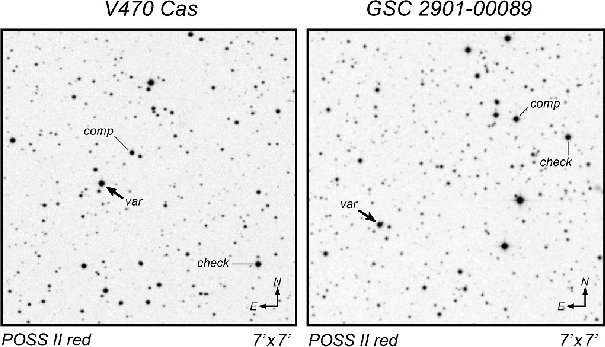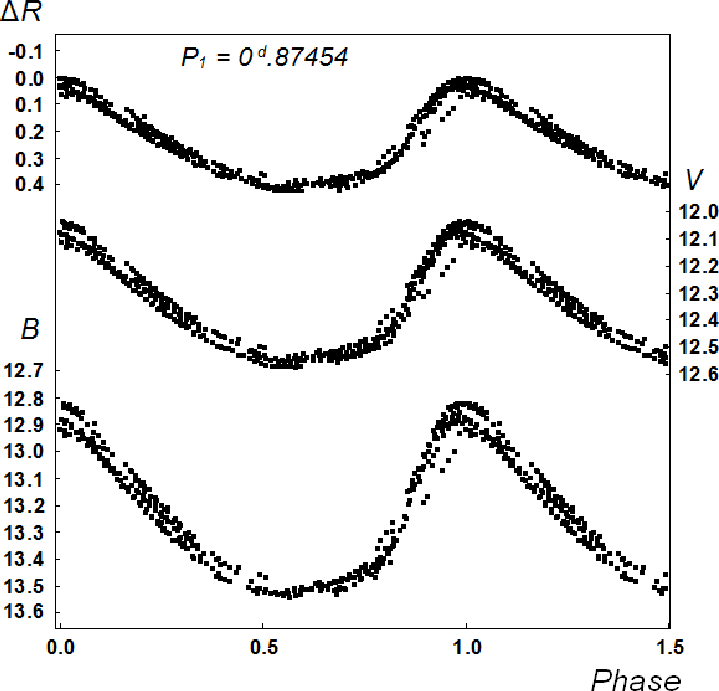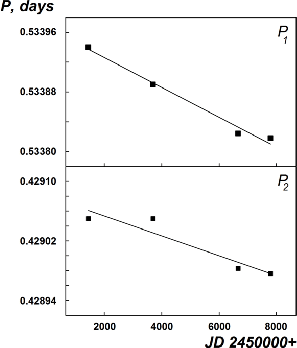|
Peremennye Zvezdy (Variable Stars) 39, No. 4, 2019 Received 11 December; accepted 18 December.
|
Article in PDF |
V470 Cas and GSC 02901-00089, Two New Double-mode Cepheids
A. V. Khruslov1,2, A. V. Kusakin3, I. V. Reva3
![]() Sternberg Astronomical Institute, Moscow State
University, Universitetsky pr. 13, 119992, Moscow, Russia; e-mail:
khruslov@bk.ru
Sternberg Astronomical Institute, Moscow State
University, Universitetsky pr. 13, 119992, Moscow, Russia; e-mail:
khruslov@bk.ru
![]() Institute of Astronomy, Russian Academy of Sciences,
Pyatnitskaya Str. 48, 119017, Moscow, Russia
Institute of Astronomy, Russian Academy of Sciences,
Pyatnitskaya Str. 48, 119017, Moscow, Russia
![]() Fesenkov Astrophysical Institute, Observatory 23,
050020, Almaty, Kazakhstan; e-mail: un7gbd@gmail.com
Fesenkov Astrophysical Institute, Observatory 23,
050020, Almaty, Kazakhstan; e-mail: un7gbd@gmail.com
| ISSN 2221–0474 | DOI: 10.24411/2221-0474-2019-10006 |
|
We present a photometric study of two new double-mode
Cepheids, pulsating in the first and second overtones modes:
V470 Cas and GSC 02901-00089. For the search for double-mode
variability, we used all available observations from the
ROTSE-I/NSVS and 1SWASP online public archives. Our multicolour
CCD observations in the |
1. Introduction
Classical Cepheid are radially pulsating periodic variable stars. Pulsations of single-period Cepheids occur in the fundamental mode (F) or in the first overtone mode (1O). In addition, several examples of possible second-overtone (2O) Cepheids are known. The double-mode Cepheids (or beat Cepheids) pulsate simultaneously in two radial pulsation modes: in the fundamental mode and in the first overtone mode (F/1O) or in the first and second overtone modes (1O/2O). There are known cases of triple-mode pulsations, F/1O/2O or 1O/2O/3O (3O being a possible third overtone mode).
The period ratio is a good indicator of the excited modes.
Characteristic period ratios are
![]() and
and
![]() . The mass of the Cepheid can be derived using the
two pulsation periods only. The first results based on the linear
theory of stellar pulsations were obtained by Petersen (1973). For
recent results of non-linear modelling of double-mode Cepheids,
see Smolec & Moskalik (2010).
. The mass of the Cepheid can be derived using the
two pulsation periods only. The first results based on the linear
theory of stellar pulsations were obtained by Petersen (1973). For
recent results of non-linear modelling of double-mode Cepheids,
see Smolec & Moskalik (2010).
The group of the double-mode Cepheids is known for more than half
a century. Florya (1937) discovered double periodicity of AC And
(later proved to be a triple-mode star). Oosterhoff (1957) was the
first to detect a group of ![]() Cephei variable stars with a
large scatter in their photoelectric phased light curves, because
of superposition of two oscillations. Later, double periodicity
oscillations in the fundamental mode and first overtone were
confirmed for most of these stars. The first Cepheid pulsating in
the first and second overtones, CO Aur, was discovered by
Mantegazza (1983). To date, according to AAVSO-VSX
database1, there are 58 F/1O
(type DCEP(B)) and 97 1O/2O (type DCEPS(B)) beat Cepheids known in
the Galaxy. Also, several galactic triple-mode stars with periods
in the Cepheid range have been detected.
Cephei variable stars with a
large scatter in their photoelectric phased light curves, because
of superposition of two oscillations. Later, double periodicity
oscillations in the fundamental mode and first overtone were
confirmed for most of these stars. The first Cepheid pulsating in
the first and second overtones, CO Aur, was discovered by
Mantegazza (1983). To date, according to AAVSO-VSX
database1, there are 58 F/1O
(type DCEP(B)) and 97 1O/2O (type DCEPS(B)) beat Cepheids known in
the Galaxy. Also, several galactic triple-mode stars with periods
in the Cepheid range have been detected.
Double-mode Cepheids are well represented in the Large (LMC) and Small (SMC) Magellanic Clouds. According to the OGLE-IV survey (Soszynski et al., 2015), in the LMC, there are 95 F/1O and 322 1O/2O Cepheids; in the SMC, there are 68 F/1O and 239 1O/2O Cepheids. Also, several triple-mode 1O/2O/3O stars are known (7 in LMC and one in SMC), and stars of F/1O/2O, 1O/3O and 2O/3O types in LMC (one case each).
In this paper, we present a photometric study of two new double-mode Cepheids, pulsating in the first and second overtone modes: V470 Cas and GSC 02901-00089. Our results were preliminarily announced by Khruslov & Kusakin (2016).
2. Observations and data reduction
In this paper, we analyze the data of available photometric archives and our CCD observations. The light curves, power spectra, photometric data from the archives and from our CCD observations, light curves are available online in the html version of this paper as a zip file. The results of our CCD observations are presented in the figures in the main text of this paper. The tables include the results of all our data analysis.
We analyzed the time series using Deeming's method (Deeming, 1975), implemented in the WinEfk code written by V.P. Goranskij.
2.1. NSVS and 1SWASP data
To search for double-mode variability, we used all available observations from the Northern Sky Variability Survey (ROTSE-I/NSVS2, Wozniak et al. 2004) and the Wide Angle Search for Planets (1SWASP3, Butters et al. 2010) online public archives. The 1SWASP observations are available as FITS tables, which were converted into ASCII tables using the OMC2ASCII program as described by Sokolovsky (2007); we also used the SuperWASP FITS to ASCII lightcurve conversion service4.
Based on these data, we reliably classified GSC 02901-00089 as a 1O/2O Cepheid, and suspected double periodicity of V470 Cas.
2.2. Our CCD observations
To confirm the double-mode variability and photometric study of
these stars, we started multicolor CCD observations in 2013. Our
CCD observations in the Johnson ![]() ,
, ![]() and
and ![]() bands were
performed at the Tien Shan Astronomical Observatory of the
V.G. Fesenkov Astrophysical Institute, at the altitude of 2750 m
above the sea level. The observatory has two Zeiss 1000-mm
telescopes. Most of our observations were performed with the
eastern Zeiss 1000-mm reflector (the focal length of the system
was
bands were
performed at the Tien Shan Astronomical Observatory of the
V.G. Fesenkov Astrophysical Institute, at the altitude of 2750 m
above the sea level. The observatory has two Zeiss 1000-mm
telescopes. Most of our observations were performed with the
eastern Zeiss 1000-mm reflector (the focal length of the system
was ![]() mm before JD 2456500 and 6650 mm after this date;
the detector was an Apogee U9000 D9 CCD camera; the chip was
cooled to
mm before JD 2456500 and 6650 mm after this date;
the detector was an Apogee U9000 D9 CCD camera; the chip was
cooled to ![]() C). The time interval of the observations
for GSC 02901-00089 is JD 2456364-2456963 (March 12, 2013 -
November 1, 2014); for V470 Cas, it is JD 2456575-2456964
(October 9, 2013 - November 2, 2014). Additionally, for
observations of V470 Cas during two nights (JD 2456899 and
2456959), we used the newly introduced western Zeiss 1000-mm
reflector (the focal length of the system was
C). The time interval of the observations
for GSC 02901-00089 is JD 2456364-2456963 (March 12, 2013 -
November 1, 2014); for V470 Cas, it is JD 2456575-2456964
(October 9, 2013 - November 2, 2014). Additionally, for
observations of V470 Cas during two nights (JD 2456899 and
2456959), we used the newly introduced western Zeiss 1000-mm
reflector (the focal length of the system was ![]() mm, the
detector being an Apogee F16M CCD camera); during one night, JD
2456584, we used the 360-mm Ritchey-Chretien telescope designed
by V.B. Sekirov (the focal length of the system is 1440 mm; the
detector was an ST-402 SBIG CCD camera; the chip was cooled to
mm, the
detector being an Apogee F16M CCD camera); during one night, JD
2456584, we used the 360-mm Ritchey-Chretien telescope designed
by V.B. Sekirov (the focal length of the system is 1440 mm; the
detector was an ST-402 SBIG CCD camera; the chip was cooled to
![]() C).
C).
Reductions were performed using the MaxIm DL aperture photometry package. For GSC 02901-00089, we obtained a homogeneous observation set. For V470 Cas, exposures of different lengths were used, and we obtained a non-homogeneous observations set. In addition, the small amplitude of the second oscillation, 2O, requires minimal observation errors. Therefore, we averaged individual values over time intervals of nearly the same duration, each point being an average of 3-6 individual observations.
Information on the comparison stars and check stars used in our
CCD photometry for the two Cepheids is presented in Table 1.
Magnitudes of the comparison stars (in Johnson's ![]() and
and ![]() bands) were taken from the AAVSO Photometric All-Sky Survey
(APASS, http://www.aavso.org/download-apass-data) catalog. The
bands) were taken from the AAVSO Photometric All-Sky Survey
(APASS, http://www.aavso.org/download-apass-data) catalog. The
![]() -band observations could be presented only as magnitude
differences with respect to the comparison star. For GSC
02901-00089, the magnitude differences
-band observations could be presented only as magnitude
differences with respect to the comparison star. For GSC
02901-00089, the magnitude differences ![]() in the
in the ![]() band are
band are
![]() ; for V470 Cas,
; for V470 Cas,
![]() .
.
The finding charts of the two Cepheids are displayed in Fig. 1.
| Variable | V470 Cas | GSC 02901-00089 | |
| Compar. | Name | GSC 03678-00722 | GSC 02901-00493 |
| star | Coord., J2000 | 01 |
04 |
| 13.937 | 12.827 | ||
| 14.755 | 13.326 | ||
| Check | Name | GSC 03678-01408 | USNO-B1.0 1329-0132855 |
| star | Coord., J2000 | 01 |
04 |
2.3. ASAS-SN data
Later, we have improved and supplemented our results using data of
the All-Sky Automated Survey for Supernovae
(ASAS-SN5, Shappee et al., 2014
and Kochanek et al., 2017). We used the ![]() photometric band of
this survey.
photometric band of
this survey.
3. V470 Cas
3.1. Earlier studies
The variability of V470 Cas = S8459 (
![]() , J2000) was discovered by
Hoffmeister (1964). The variable was classified as a
short-periodic variable (possibly eclipsing), the variability
range was 12
, J2000) was discovered by
Hoffmeister (1964). The variable was classified as a
short-periodic variable (possibly eclipsing), the variability
range was 12![]() 5 - 13
5 - 13![]() 0. The first study of the variability
of V470 Cas was published by Meinunger (1968) who classified the
star as an eclipsing variable with the light elements:
0. The first study of the variability
of V470 Cas was published by Meinunger (1968) who classified the
star as an eclipsing variable with the light elements:
MinI
![]() .
.
The variability range is 13![]() 0 - 13
0 - 13![]() 5.
5.
Gessner & Meinunger (1973) confirmed these light elements but remarked on their being not quite certain. Eight times of light minima were reported. The variable was included in the General Catalog of Variable Stars (Samus et al., 2017) based on this publication.
Agerer et al. (1996) performed CCD observations of V470 Cas and
studied plates of the Sonneberg Sky Patrol. It was found that the
star was not an eclipsing variable. V470 Cas is a possible
RR Lyrae variable star with a long period and small amplitude. The
amplitude of variability in the instrumental system (without
filters) is 0![]() 35. Asymmetry of the light curve is more typical
of classical Cepheids (
35. Asymmetry of the light curve is more typical
of classical Cepheids (
![]() ). During the interval of
observations (photographic observations: JD 2436200-2448862, CCD
observations: JD 2449170-2450013), the period of variability
changed. Therefore, Agerer et al. (1996) gave two systems of the
light elements:
). During the interval of
observations (photographic observations: JD 2436200-2448862, CCD
observations: JD 2449170-2450013), the period of variability
changed. Therefore, Agerer et al. (1996) gave two systems of the
light elements:
for JD 2436200-2445000: HJD
![]() ;
;
for JD 2445000-2450013: HJD
![]() .
.
3.2. Analysis of survey photometric data
We suspected double-mode variability of V470 Cas from NSVS and
1SWASP data. The second frequency was detected sufficiently
reliably in the NSVS data (for this analysis, we excluded data
with the errors
![]() ); its detection in the 1SWASP
data is much less certain. In the ASAS-SN
); its detection in the 1SWASP
data is much less certain. In the ASAS-SN ![]() -band observations,
we excluded data with the errors
-band observations,
we excluded data with the errors
![]() .
.
Our classification of V470 Cas is confirmed with its low galactic
latitude (
![]() ) and color indices
) and color indices ![]() (2MASS),
(2MASS),
![]() (Tycho2), and
(Tycho2), and ![]() (APASS), typical of
Cepheids.
(APASS), typical of
Cepheids.
3.3. CCD observations
Our CCD observations completely confirmed the double-mode nature
of V470 Cas: this star is a double-mode Cepheid, pulsating in the
first and second overtone modes. The period ratio
![]() is typical of the double-mode 1O/2O variables.
is typical of the double-mode 1O/2O variables.
The light elements of the two pulsations for all data sets are
presented in Table 2. Semi-amplitudes of the individual
oscillations and variability ranges in individual bands are
collected in Table 3. Besides the first and second overtone
frequencies, we detected one interaction frequency, ![]() , of
V470 Cas in our CCD data.
, of
V470 Cas in our CCD data.
CCD light curves of V470 Cas in the ![]() ,
, ![]() , and
, and ![]() bands are
displayed in Figs. 2 and 3. The power spectra according to CCD
observations are displayed in Fig. 4. The structure of the power
spectra leaves no doubt that
bands are
displayed in Figs. 2 and 3. The power spectra according to CCD
observations are displayed in Fig. 4. The structure of the power
spectra leaves no doubt that ![]() is a real frequency.
is a real frequency.
| Data | Epoch |
Epoch |
|||
| NSVS | 0.8744 | 2451510.732 | 0.7028 | 2451510.920 | - |
| 1SWASP | 0.8745 | 2454390.438 | 0.7025 | 2454390.425 | - |
| CCD | 0.87454 | 2456789.160 | 0.70217 | 2456789.670 | 0.389467 |
| ASAS-SN | 0.87454 | 2457777.400 | 0.70214 | 2457777.575 | 0.389460 |
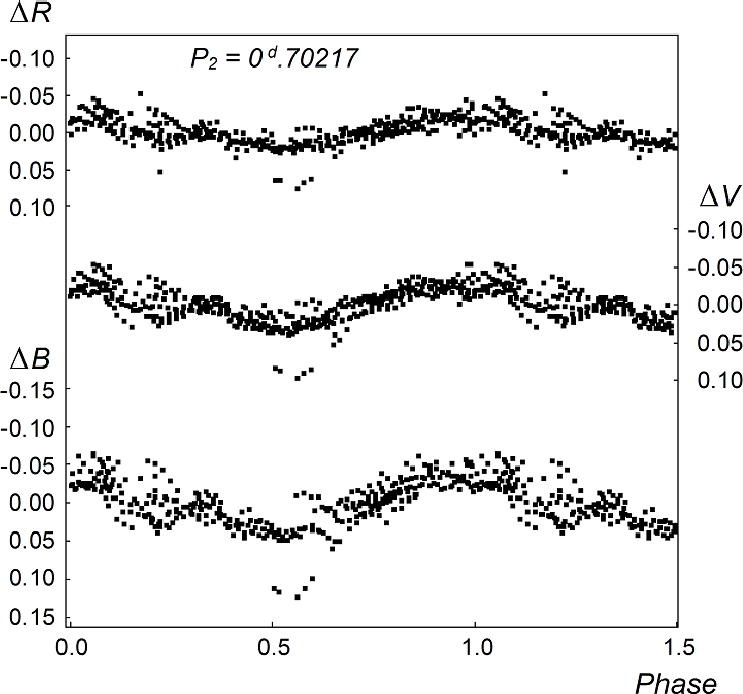 |
Fig. 3.
CCD observations: light curves in |
| Band | mag | |||
| NSVS (R) | 0.137 | 0.026 | - | 11.95 - 12.40 |
| 1SWASP | 0.189 | 0.015 | - | 11.92 - 12.42 |
| 0.3327 | 0.0364 | 0.0176 | 12.82 - 13.54 | |
| 0.2447 | 0.0252 | 0.0116 | 12.03 - 12.58 | |
| 0.1910 | 0.0185 | 0.0092 | 0.42 | |
| ASAS-SN, |
0.207 | 0.040 | 0.019 | 11.93 - 12.53 |
3.4. Period variations
Period variations of the first overtone oscillation (![]() ) can be
represented by an
) can be
represented by an ![]() diagram, see Fig. 5. The parabolic shape
of this diagram is typical of secular period variations of
classical Cepheids, the period is increasing systematically.
Figure 5 is based on linear light elements for the middle of the
time interval:
diagram, see Fig. 5. The parabolic shape
of this diagram is typical of secular period variations of
classical Cepheids, the period is increasing systematically.
Figure 5 is based on linear light elements for the middle of the
time interval:
HJD(max)
![]() .
.
Before JD 2449000, all points are times of high brightness according to photographic photometry; after JD 2449000, all points are CCD maxima. We used the data from Agerer et al. (1996), Agerer & Huebscher (2002), Huebscher (2005), Huebscher et al. (2005), Huebscher et al. (2006), Huebscher et al. (2009), Huebscher et al. (2010), Huebscher & Lehmann (2012), and data from our study.
Period of second overtone ![]() also varies (decreases), see Table 2.
also varies (decreases), see Table 2.
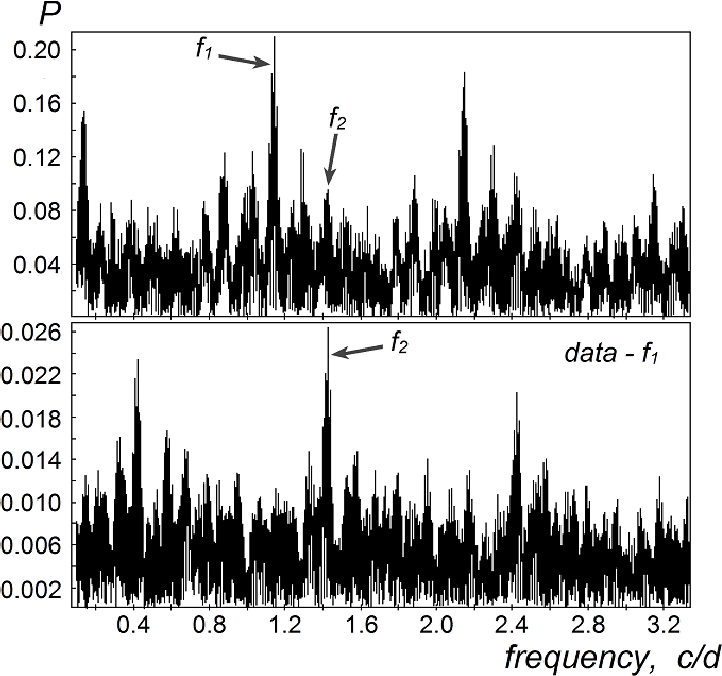 |
Fig. 4.
Power spectra of V470 Cas for the
frequencies |
4. GSC 02901-00089
4.1. Earlier studies
The variability of GSC 02901-00089 (
![]() ,
J2000) was reported by Hoffman et al. (2009) from ROTSE-I/NSVS
data (NSVS 4346946). The variable was classified as an RR Lyrae
star with the period of 0.53391 days.
,
J2000) was reported by Hoffman et al. (2009) from ROTSE-I/NSVS
data (NSVS 4346946). The variable was classified as an RR Lyrae
star with the period of 0.53391 days.
Later, we classified GSC 02901-00089 as a 1O/2O double-mode Cepheid (Khruslov 2013) using all available observations from the ROTSE-I/NSVS and SuperWASP online public archives. In the cited paper, we presented the preliminary results. The paper contained only the two periods and the new classification, CEP(B) variability type in the GCVS classifications system (Samus et al., 2017). Now we have re-analysed NSVS, 1SWASP and ASAS-SN data and our CCD observations, confirmed the 1O/2O double periodicity of GSC 02901-00089, and improved its light elements.
4.2. Analysis of survey photometric data
We detected double-mode variability of GSC 02901-00089 from NSVS
and 1SWASP data. For this analysis, we excluded data with the
errors
![]() in the NSVS data, and the errors
in the NSVS data, and the errors
![]() in the 1SWASP data. In the ASAS-SN
in the 1SWASP data. In the ASAS-SN ![]() -band
observations, we excluded data with the errors
-band
observations, we excluded data with the errors
![]() .
.
Our classification is confirmed with the low galactic latitude
![]() and with the color indices
and with the color indices ![]() (2MASS),
(2MASS), ![]() (APASS).
(APASS).
4.3. CCD observations
Our CCD observations completely confirmed the double-mode nature
of GSC 02901-00089: this star is a 1O/2O double-mode Cepheid. The
period ratio
![]() is typical of variables of this
type. Besides the first and second overtone frequencies, we
detected two interaction frequencies of GSC 02901-00089,
is typical of variables of this
type. Besides the first and second overtone frequencies, we
detected two interaction frequencies of GSC 02901-00089, ![]() and
and ![]() , in our CCD data.
, in our CCD data.
The light elements of the two pulsations for all data sets are
presented in Table 4: the first-overtone period ![]() and epoch,
the second-overtone period
and epoch,
the second-overtone period ![]() and epoch, periods for the
frequencies
and epoch, periods for the
frequencies ![]() and
and ![]() . The periods and epochs
are given for all individual data sets. Semi-amplitudes of the
individual oscillations and the variability ranges in different
bands are collected in Table 5. For the
. The periods and epochs
are given for all individual data sets. Semi-amplitudes of the
individual oscillations and the variability ranges in different
bands are collected in Table 5. For the ![]() band, we give the full
variability amplitude (peak to peak).
band, we give the full
variability amplitude (peak to peak).
The CCD light curves in the ![]() ,
, ![]() , and
, and ![]() bands for
GSC 02901-00089 are displayed in Figs. 6 and 7. The power spectra
according to CCD observations are shown in Fig. 8. The structure
of the power spectra leaves no doubt that
bands for
GSC 02901-00089 are displayed in Figs. 6 and 7. The power spectra
according to CCD observations are shown in Fig. 8. The structure
of the power spectra leaves no doubt that ![]() is a real
frequency.
is a real
frequency.
4.4. Period variations
The periods of the first and second overtone oscillations vary
significantly, see Table 4. We can claim it beyond doubt for ![]() (progressive decrease). The diagram of the period variations of
GSC 02901-00089 is displayed in Fig. 9.
(progressive decrease). The diagram of the period variations of
GSC 02901-00089 is displayed in Fig. 9.
| Data | Epoch |
Epoch |
||||
| NSVS | 0.53394 | 2451450.393 | 0.42905 | 2451450.387 | - | - |
| 1SWASP | 0.53389 | 2453700.227 | 0.42905 | 2453700.333 | 0.23796 | - |
| CCD | 0.533824 | 2456650.325 | 0.428983 | 2456650.288 | 0.237848 | 2.1843 |
| ASAS-SN | 0.533818 | 2457777.770 | 0.428976 | 2457777.630 | 0.237845 | 2.1844 |
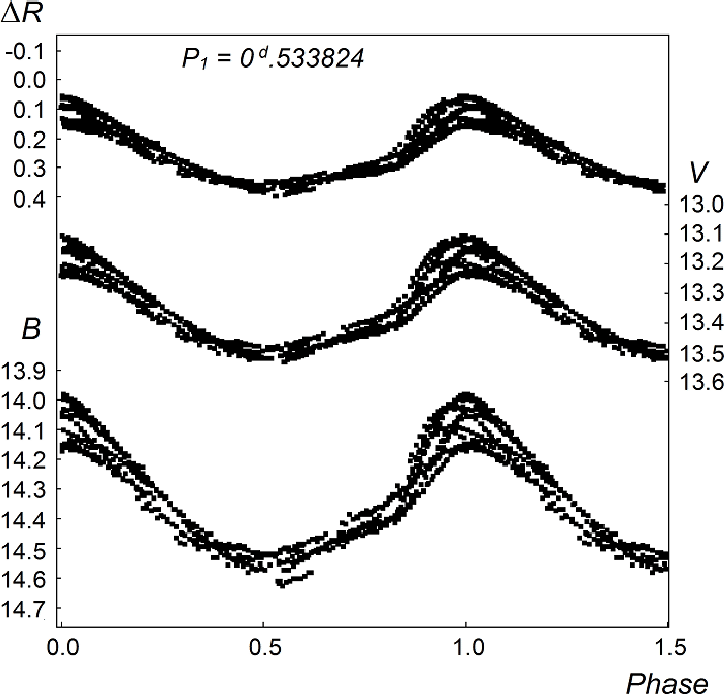 |
Fig. 6.
CCD observations: light curves in |
| Band | mag | ||||
| NSVS | 0.119 | 0.029 | - | - | 12.9 - 13.35 |
| 1SWASP | 0.179 | 0.044 | 0.017 | - | 12.74 - 13.37 |
| 0.2349 | 0.0418 | 0.0154 | 0.0115 | 13.98 - 14.63 | |
| 0.1626 | 0.0289 | 0.0114 | 0.0094 | 13.11 - 13.54 | |
| 0.1278 | 0.0209 | 0.0091 | 0.0075 | 0.34 | |
| ASAS-SN, |
0.133 | 0.028 | 0.012 | 0.009 | 13.02 - 13.46 |
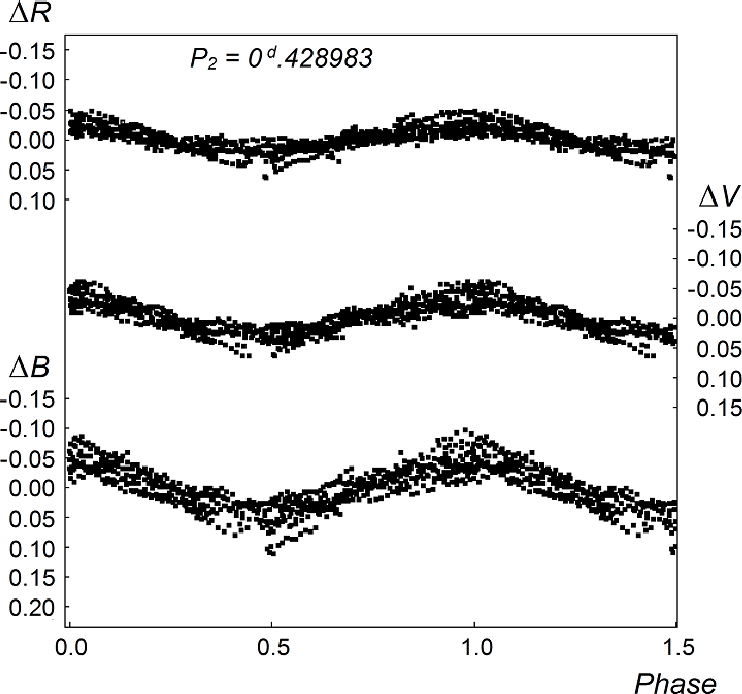 |
Fig. 7.
CCD observations: light curves in |
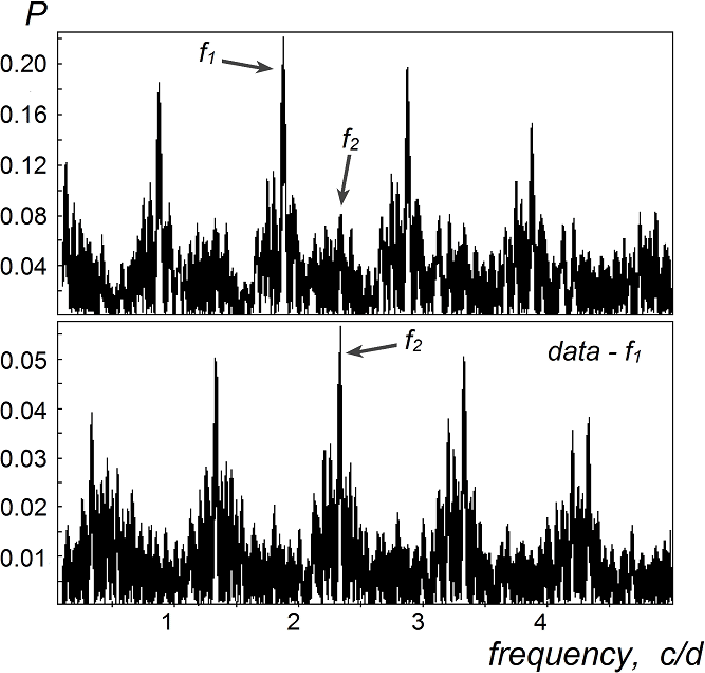 |
Fig. 8.
Power spectra of GSC 02901-00089 for the
frequencies |
Acknowledgments: The authors are grateful to Dr. V. P.
Goranskij for providing light-curve analysis software. Thanks are
due to Drs. S.V. Antipin and N.N. Samus for helpful discussions
and to Dr. K.V. Sokolovsky for his advice concerning data
retrieving. We wish to thank M.A. Krugov, N.V. Lichkanovsky,
I.V. Rudakov, R.I. Kokumbaeva, and W. Mundrzyjewski for their
assistance during the observations.
This study was supported in part by the Programme No. 12 "Origin and Evolution of the Universe from Ground-based Observations and Space Studies" of the Presidium of Russian Academy of Sciences. It was carried out within the framework of Project No. BR05236322 "Studies of physical processes in extragalactic and galactic objects and their subsystems", financed by the Ministry of Education and Science of the Republic of Kazakhstan.
References:
Agerer, F., Kleikamp, W., Moschner, W., Splittgerber, E. 1996, Inform. Bull. Var. Stars, No. 4332
Agerer, F., Huebscher, J. 2002, Inform. Bull. Var. Stars, No. 5296
Butters, O. W., West, R. G., Anderson, D. R., et al. 2010, Astron. & Astrophys., 520, L10
Deeming, T. J., 1975, Astrophys. & Space Sci., 36, 137
Florya, N. F. 1937, Astron. Zh., 14, 32
Gessner, H., Meinunger, I. 1973, Veröff. Sternwarte Sonn., 7, 607
Hoffman, D. I., Harrison, T. E., McNamara, B. J. 2009, Astron. J., 138, 466
Hoffmeister, C. 1964, Astron. Nachr., 288, 49
Huebscher, J. 2005, Inform. Bull. Var. Stars, No. 5643
Huebscher, J., Paschke, A., Walter, F. 2005, Inform. Bull. Var. Stars, No. 5657
Huebscher, J., Paschke A., Walter F. 2006, Inform. Bull. Var. Stars, No. 5731
Huebscher, J., Steinbach, H. -M., Walter, F. 2009, Inform. Bull. Var. Stars, No. 5889
Huebscher, J., Lehmann, P. B., Monninger, G., et al. 2010, Inform. Bull. Var. Stars, No. 5918
Huebscher, J., Lehmann, P. B. 2012, Inform. Bull. Var. Stars, No. 6026
Khruslov, A. V. 2013, Astron. Nachr., 334, 866
Khruslov, A. V., Kusakin, A. V. 2016, arXiv: 1605.01313v1
Kochanek, C. S., Shappee, B. J., Stanek, K. Z., et al., 2017, Publ. Astron. Soc. Pacific, 129, 104502
Mantegazza, L. 1983, Astron. & Astrophys., 118, 321
Meinunger, I. 1968, Mitteilungen Ver. Sterne, 5, 12
Oosterhoff, P. Th. 1957, Bull. Astron. Inst. Netherlands, 13, 317
Petersen, J. O. 1973, Astron. & Astrophys., 27, 89
Samus, N. N., Kazarovets, E. V., Durlevich, O. V., Kireeva, N. N., Pastukhova, E. N., 2017, Astron. Rep., 61, 80
Shappee, B. J., Prieto, J. L., Grupe, D., et al., 2014, Astrophys. J., 788, 48
Smolec, R., Moskalik, P. 2010, Astron. & Astrophys., 524, A40, 12
Sokolovsky, K. V. 2007, Perem. Zvezdy Prilozh., 7, No. 30
Soszynski, I., Udalski, A., Szymanski, M. K., et al. 2015, Acta Astron., 65, 297
Wozniak, P. R., Vestrand, W. T., Akerlof, C. W., et al. 2004, Astron. J., 127, 2436
